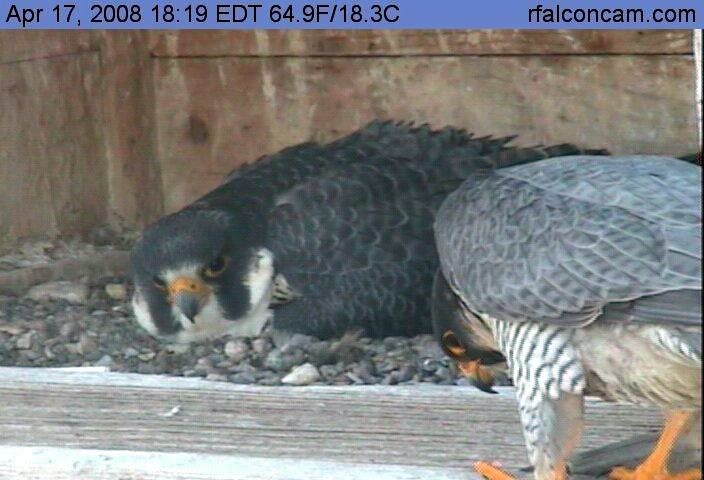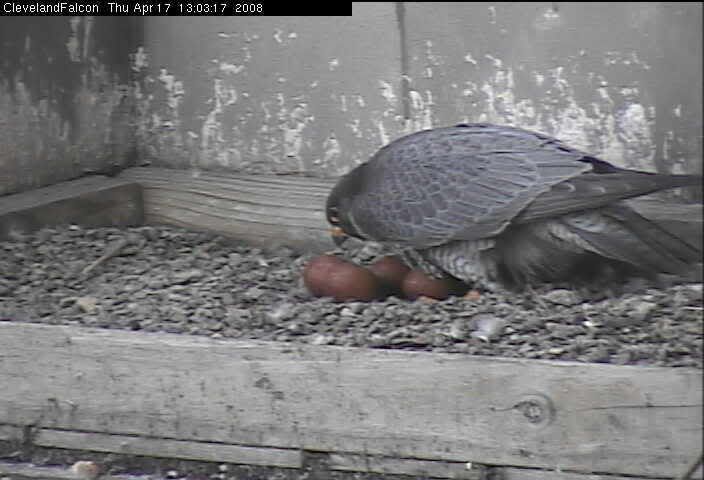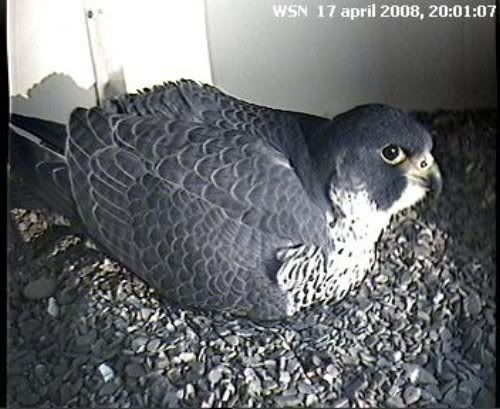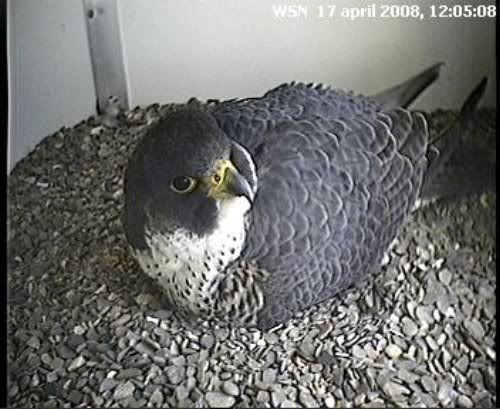
Thursday, April 17, 2008
Brighton Sussex Heights

 Last year the female laid 4 eggs as well, from which however only 2 hatched. Both eyases stayed healthty and fledged on June 15.
Last year the female laid 4 eggs as well, from which however only 2 hatched. Both eyases stayed healthty and fledged on June 15.Hopefully this year all 4 eggs will hatch. Th efirst one should on April 26. So lets keep our talons crossed.
Labels:
Brighton,
peregrine falcon,
Sussex Height Peregrines
Indianapolis
Cobb Island
Bologna




Both eyases are 2 weeks old today. They spent the best part of the day alone together. Their seconf down is complete and that's why they have their own thermo regulation. They can keep their bodytemperature constant without protection of the parents.
They are fed frequently about 4-5 times a day for longer periods. When they where born their weight was about 45 grams. After 1 week that has doubled to 90-100 grams. When they are 4 weeks their weight will be about that of their father. So a lot of food is needed to acomplish this growrate.
Eyases go through 2 molts in 46 days! Imagine how much energy and nutrients that takes. Feathers are made mainly out of proteine. So a lot of that is needed. First the second down has to grow and next the complete brown plumage. The second down consists of 2 types: preplumlae that stick to the plumulae and plumulae. Around the 10th days the first primary feathershaft start appearing. They grow about 2-3 mm a day. You can notice that by the bleu-ish edges of the wings.
Eyases from day to day
 Click the pictures to enlarge
Click the pictures to enlargeCondition At Hatching
The peregrine falcon eyases are semialtricial, nidicolous; covered with off-white (prepenne) down. Semi altricial means: Covered with down, incapable of departing from the nest, and fed by the parents. In species like the peregrine falcon we speak of semi-altricial 2, hatch with the eyes closed.
The bill and feet pinkish to pale gray with eyes closed. They weigh about 35–40 g. If eyes open with food-begging first day, they are slitlike. The eyases obtain 2 downy plumages.

Growth and development
At 5 days after hatch, their mass has doubled. The eyas can sit with relative ease, and the open eyes are more round.
At 6–8 days of age the second down (mesoptile or preplumulae) starts to emerge, first on humeral and alar tracts but no down visible on belly at 6 day, although on the legs and belly at 8 days.
Also second down is well out on the wings and looks a bit blueish and sheaths of primaries breaking skin on wings.

By 10 days of age the second down is complete and uniform and outer rectrices are breaking skin. At 10 days, primaries growing at 2–3 mm/d, rectrix sheath not yet split.
At 14 days the second down is dense and long, rectrix sheath about 2 mm and typically ninth primary emerges from sheath.
By day 17 the contour feathers start to push out prepennae and only pale (buffy) tips of rectrices have emerged but growing at about 2 mm/d (since day 13).

By 10 days of age the second down is complete and uniform and outer rectrices are breaking skin. At 10 days, primaries growing at 2–3 mm/d, rectrix sheath not yet split.
At 14 days the second down is dense and long, rectrix sheath about 2 mm and typically ninth primary emerges from sheath.
By day 17 the contour feathers start to push out prepennae and only pale (buffy) tips of rectrices have emerged but growing at about 2 mm/d (since day 13).

At 20 days while still with heavy coat of second down, brown contour feathers are visible on margins of wings, tail, and faintly around the eyes.
By 30 days young appears about half down-covered and half feathered; while side of face well feathered, crown still covered with down.

At 35 days while mostly feathered, large conspicuous patches of down around legs, under wings, and on crown.
At 40 days almost fully feathered with traces of down on crown and under wings and outer several remiges; rectrices not fully grown but bird capable of weak flight.
From my Peregrine falcon website:
Copyright Froona
All Rights reserved
Subscribe to:
Comments (Atom)














































